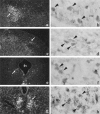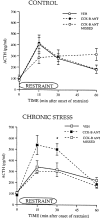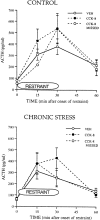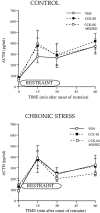A cholecystokinin-mediated pathway to the paraventricular thalamus is recruited in chronically stressed rats and regulates hypothalamic-pituitary-adrenal function
- PMID: 10884340
- PMCID: PMC6772345
- DOI: 10.1523/JNEUROSCI.20-14-05564.2000
A cholecystokinin-mediated pathway to the paraventricular thalamus is recruited in chronically stressed rats and regulates hypothalamic-pituitary-adrenal function
Abstract
Chronic stress alters hypothalamic-pituitary-adrenal (HPA) responses to acute, novel stress. After acute restraint, the posterior division of the paraventricular thalamic nucleus (pPVTh) exhibits increased numbers of Fos-expressing neurons in chronically cold-stressed rats compared with stress-naive controls. Furthermore, lesions of the PVTh augment HPA activity in response to novel restraint only in previously stressed rats, suggesting that the PVTh is inhibitory to HPA activity but that inhibition occurs only in chronically stressed rats. In this study, we further examined pPVTh functions in chronically stressed rats. We identified afferent projections to the pPVTh using injection of the retrograde tracer fluorogold. Of the sites containing fluorogold-labeled cells, neurons in the lateral parabrachial, periaqueductal gray, and dorsal raphe containing fluorogold also expressed cholecystokinin (CCK) mRNA. We then examined whether these CCKergic inputs to the pPVTh were involved in HPA responses to acute, novel restraint after chronic stress. We injected the CCK-B receptor antagonist PD 135,158 into the PVTh before restraint in control and chronically cold-stressed rats. ACTH responses to restraint stress were augmented by PD 135,158 only in chronically stressed rats but not in controls. In addition, CCK-B receptor mRNA expression in the pPVTh was not altered by chronic cold stress. We conclude that previous chronic stress specifically facilitates the release of CCK into the pPVTh in response to acute, novel stress. The CCK is probably secreted from neurons in the lateral parabrachial, the periaqueductal gray, and/or the dorsal raphe nuclei. Acting via CCK-B receptors in pPVTh, CCK then constrains facilitated ACTH responses to novel stress in chronically stressed but not naive rats. These results demonstrate clearly that chronic stress recruits a new set of pathways that modulate HPA responsiveness to a novel stress.
Figures









References
-
- Akana SF, Dallman MF. Chronic cold in adrenalectomized, corticosterone (B)-treated rats: facilitated corticotropin responses to acute restraint emerge as B increases. Endocrinology. 1997;138:3249–3258. - PubMed
-
- Akana SF, Hanson ES, Horsley CJ, Strack AM, Bhatnagar S, Bradbury MJ, Milligan ED, Dallman MF. Clamped corticosterone (B) reveals the effect of endogenous B on both facilitated responsivity to acute restraint and metabolic responses to chronic stress. Stress. 1996;1:33–49. - PubMed
-
- Armario A, Lopzez-Calderon A, Jolin T, Balasch J. Response of anterior pituitary hormones to chronic stress. The specificity of adaptation. Neurosci Biobehav Rev. 1986;10:245–250. - PubMed
-
- Bandler R, Shipley MT. Columnar organization of the midbrain periaqueductal gray: modules for emotional expression? Trends Neurosci. 1994;17:379–389. - PubMed
-
- Benedetti F. Cholecystokinin type A and type B receptors and their modulation of opioid analgesia. News Physiol Sci. 1997;12:263–268.
Publication types
MeSH terms
Substances
LinkOut - more resources
Full Text Sources
